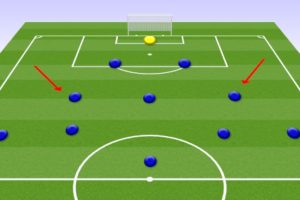What is a Sweeper Keeper? Exploring the Role and Responsibilities of this Soccer Position
A sweeper-keeper is a goalkeeper who has a unique playing style that involves playing a more active role in the game than most traditional goalkeepers. Sweeper-keepers are known to be aggressive and proactive when it comes to defending their goalposts. They are often seen outside their box, making tackles and intercepting passes, and are also skilled in distributing the ball.
The sweeper-keeper position has become increasingly popular in modern football, with many top teams incorporating it into their playing style. The concept of a sweeper-keeper is not entirely new, but the role has evolved over the years, with more emphasis being placed on the keeper’s ability to be involved in the game and help their team build attacks from the back.
Unlike traditional goalkeepers, sweeper-keepers are not just expected to keep the ball out of their net; they are also expected to contribute to their team’s attack. By being more involved in the game, sweeper-keepers can help their team maintain possession and launch counter-attacks quickly. This article will delve deeper into what a sweeper-keeper is, how they differ from traditional goalkeepers, and the skills required to excel in this position.
Read our guide to soccer positions
Definition of a Sweeper Keeper

A Sweeper Keeper is a type of goalkeeper who is highly active outside of their penalty area. They are often involved in the build-up play and are quick to move off their line to clear through balls if the situation arises. The Sweeper Keeper is in the same vein as a traditional Sweeper, but with the added benefit of being a goalkeeper.
The Sweeper Keeper is a modern tactical innovation that has become increasingly popular in recent years. The Sweeper Keeper’s role is to act as an extra defender, providing an outlet for the team’s defenders to pass the ball to when under pressure. The Sweeper Keeper is responsible for sweeping up any loose balls behind the defence and clearing them away from danger.
| Key Characteristics of a Sweeper Keeper |
|---|
| Highly active outside of their penalty area |
| Involved in the build-up play |
| Quick to move off their line to clear through balls |
| Acts as an extra defender |
| Provides an outlet for the team’s defenders to pass the ball to when under pressure |
| Responsible for sweeping up any loose balls behind the defence and clearing them away from danger |
The Sweeper Keeper is often used by teams that like to play a high defensive line, as they can cover the space behind the defence and prevent opposition attackers from getting in behind. The Sweeper Keeper is also useful when a team is playing against a high-pressing opposition, as they can receive the ball from the defenders and quickly distribute it to the midfielders or attackers.
Overall, the Sweeper Keeper is an important tactical innovation that has become increasingly popular in modern football. They provide an extra layer of defence and are highly involved in the build-up play, making them a valuable asset to any team.
History of Sweeper Keepers
The concept of the Sweeper Keeper position has been around for a long time, but it wasn’t until the 1960s that it started to become recognized as a unique role on the field. The first Sweeper Keeper was arguably Gyula Grosics, who played for Hungary in the 1950s and 60s. Grosics was known for his ability to come out of his box and act as a sweeper, clearing balls and making tackles outside of his area.
However, it was the Dutch team of the 1970s that really popularized the Sweeper Keeper position. Under the guidance of Johan Cruyff, the Netherlands played a revolutionary style of Total Football, which relied on fluid movement and players switching positions. The goalkeeper, Jan Jongbloed, was a key part of this system, often acting as a sweeper and pushing up the field to start attacks.
Since then, the Sweeper Keeper has become a staple of modern football, with many top teams employing a goalkeeper who is comfortable with the ball at their feet and can act as a sweeper when necessary. In recent years, the position has evolved even further, with some teams using a “Sweeper Keeper 2.0” who not only acts as a sweeper but also plays a more active role in the team’s build-up play.
| Notable Sweeper Keepers | Team(s) |
|---|---|
| Lev Yashin | Soviet Union, Dynamo Moscow |
| Gyula Grosics | Hungary, Tatabánya Bányász |
| Jan Jongbloed | Netherlands, FC Amsterdam |
| Manuel Neuer | Bayern Munich, Germany |
| Ederson | Manchester City, Brazil |
While the Sweeper Keeper position may not be for everyone, it has certainly had a significant impact on the game of football. From Grosics to Neuer, Sweeper Keepers have shown that a goalkeeper can be more than just a shot-stopper, and can play an important role in a team’s overall style of play.
Roles and Responsibilities
Defensive Duties
A Sweeper Keeper is primarily a goalkeeper, and as such, their primary responsibility is to keep the ball out of the net. However, a Sweeper Keeper is also expected to be an extra defender and take on more defensive duties than a traditional goalkeeper. They are expected to control the space behind their defense and push high up the pitch, almost acting as an eleventh outfield player. They must be comfortable coming outside of their area to receive or win the ball back and be involved in the build-up play of the team.
When their team is in possession of the ball, the Sweeper Keeper is expected to drop deeper and provide cover for their defense in case of a counter-attack. They must be quick off their line to close down the opposition striker and clear the ball away from danger. They must also have good communication skills to organize their defense and ensure that everyone is in the right position.
Offensive Duties
When their team is on the attack, the Sweeper Keeper is expected to be involved in the build-up play and act as an extra outfield player. They must be comfortable with the ball at their feet and have good passing and distribution skills to start attacks from the back. They must also be able to read the game and make quick decisions about when to join the attack and when to stay back and provide cover for their defense.
In addition, the Sweeper Keeper must be able to anticipate opposition attacks and be quick off their line to intercept through balls and long passes. They must also be comfortable coming out of their area to clear the ball or make tackles when necessary.
| Defensive Duties | Offensive Duties |
|---|---|
| Keep the ball out of the net | Be involved in the build-up play |
| Control the space behind the defense | Act as an extra outfield player |
| Push high up the pitch | Have good passing and distribution skills |
| Come outside of their area to receive or win the ball back | Read the game and make quick decisions |
| Provide cover for their defense in case of a counter-attack | Anticipate opposition attacks and intercept through balls and long passes |
Overall, the Sweeper Keeper is a hybrid position that requires a unique set of skills. They must be comfortable with the ball at their feet, have good passing and distribution skills, and be able to read the game and make quick decisions. They must also be an excellent shot-stopper and have good communication skills to organize their defense.
Famous Sweeper Keepers
Over the years, there have been many famous sweeper keepers who have made a name for themselves in the world of soccer. Here are just a few of the most notable:
| Name | Country | Years Active | Notable Achievements |
|---|---|---|---|
| Lev Yashin | Russia | 1949-1971 | Won the 1960 European Championship with the Soviet Union |
| Gyula Grosics | Hungary | 1947-1962 | Won a gold medal at the 1952 Olympics and helped Hungary reach the 1954 World Cup final |
| Rene Higuita | Colombia | 1985-2007 | Known for his “scorpion kick” save and helped Colombia reach the 1990 World Cup quarterfinals |
| Manuel Neuer | Germany | 2004-present | Won the 2014 World Cup with Germany and has been named the best goalkeeper in the world multiple times |
Lev Yashin is often credited as being the first true sweeper keeper, and he was known for his ability to come out of his box and sweep up loose balls. He was also an excellent shot-stopper and helped lead the Soviet Union to the 1960 European Championship.
Gyula Grosics was another early sweeper keeper who helped revolutionize the position. Despite being just 5’8″, he was an outstanding shot-stopper and played a key role in Hungary’s run to the 1954 World Cup final.
In more recent times, Rene Higuita became known for his unorthodox style and his willingness to take risks. He was famous for his “scorpion kick” save and helped lead Colombia to the quarterfinals of the 1990 World Cup.
Finally, Manuel Neuer is widely regarded as the best sweeper keeper in the world today. He is known for his excellent footwork, his ability to play out from the back, and his shot-stopping ability. He helped lead Germany to the 2014 World Cup and has won numerous individual awards throughout his career.
Conclusion
In conclusion, a Sweeper Keeper is a goalkeeper who plays a more active role in defending by sweeping up behind the defensive line, covering for defenders who have been beaten, and intercepting passes. The Sweeper Keeper position is a high-risk, high-reward tactic that can be very effective when executed properly.
By playing a Sweeper Keeper, teams can create a more dynamic and fluid style of play, with the goalkeeper acting as an additional outfield player. This can be particularly effective when playing against teams that like to press high up the pitch, as the Sweeper Keeper can act as an outlet for the ball and help to break the opposition’s press.
However, it is important to note that not all goalkeepers are suited to playing as a Sweeper Keeper. Players who lack the technical ability, speed, and decision-making skills required for the position may struggle to adapt to the role, and may be better suited to playing as a more traditional Shot Stopper.
Overall, the Sweeper Keeper position is an exciting and innovative approach to goalkeeping that can add a new dimension to a team’s play. By using a Sweeper Keeper effectively, teams can create a more dynamic and fluid style of play, and gain a competitive advantage over their opponents.






